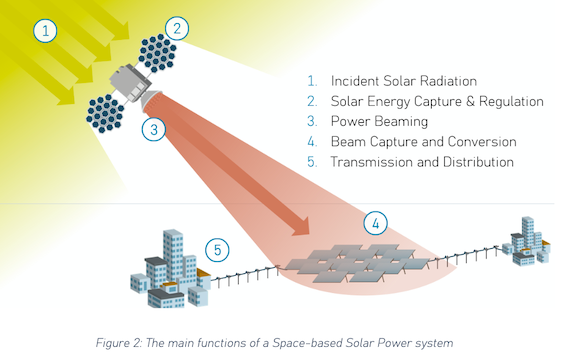Ann Arbor (Informed Comment) – The European Space Agency isn’t as well known in the U.S. as NASA or even Roscosmos, the Russian space agency. The $7 bn.-a-year agency funded by 22 European states, however, has what could turn out to be a game-changing idea for solar power. ESA is contemplating installing a solar panel array the size of a shopping mall in earth orbit. The agency has funded a three-year study called “Solaris.” I don’t know if that is a reference to Polish author Stanislaw Lem’s 1961 science fiction novel of the same name. The project is outlined at length here .
The ESA panel array, a little more than half a mile long, would generate 2 gigawatts of electrical power. That electricity would then be converted to microwaves at 2.45 GHz, and beamed to a relay station on the earth’s surface called a “rectenna.” There it will be converted back into electricity and would power about 1.5 million homes. That would make it equivalent to a sizeable nuclear power plant.

H/t ESA
This plan would address some issues with terrestrial solar panels. So far, the panels are relatively large (we have 16 on our roof and they cover a lot of it). So you need a lot of land for them. Some of this difficulty can be addressed by putting them out in a desert, but then you have the problem that you have to build high density transmission wires to take the electricity they generate to cities, the major customers for it. So you need a fair amount of land, and you need transmission capacity. Then, the panels don’t generate electricity at night, so they really need to be paired with batteries or other energy storage, which is another expense.
A solar array in space that could transmit energy in the form of microwaves would solve all three problems. There is plenty of room in outer space, they can transmit to anyplace (including to the planned moon colonies of both NASA’s Artemis program and the Chinese space program). James Purtill of the Australian Broadcasting Co. explains that the panel array can be put into an orbit such that it is always receiving sunshine, even during the earth’s night.
How space-based solar power can save the planet | FT
One reason this idea, which first originated in the mid-twentieth century, is being considered seriously again is that the cost of payloads into space has fallen dramatically, partly because of the rise of reusable rockets. Purtill says that the cost has fallen nearly 20-fold in just twenty years, and the panels have gotten lighter. ESA says that it will nevertheless take more trips to build such an array than it took to build the International Space Station. That took over 40 missions to set up.
Getting to zero carbon pollution by 2050 is a challenging task for the world, and we could use some breakthroughs. This one would be the equivalent of President Kennedy’s moonshot, though in some ways it is even less challenging in principle, since all the elements of this technology are proven and in principle we know how to do it.
President Biden has already entered the history books for being a pivotal president in the energy revolution, with his Infrastructure Act and the IRA. But if he inaugurated a program to put solar arrays into earth orbit, that would add an exclamation mark to his legacy.



 © 2025 All Rights Reserved
© 2025 All Rights Reserved